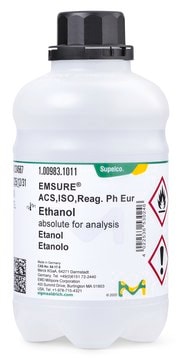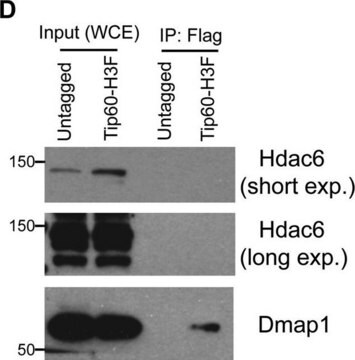Wichtige Dokumente
270741
Reagent Alcohol
≥89.0% (GC), denatured, suitable for HPLC, contains 5% isopropyl alcohol as denaturant, 5% methyl alcohol as denaturant
Synonym(e):
Ethanol, RGA, denatured alcohol
About This Item
Empfohlene Produkte
Produktbezeichnung
Reagent Alcohol, denatured, suitable for HPLC
Dampfdichte
1.59 (vs air)
Assay
≥89.0% (GC)
Form
liquid
Enthält
5% isopropyl alcohol as denaturant
5% methyl alcohol as denaturant
Expl.-Gr.
3.1-27.7 %
Methode(n)
HPLC: suitable
Verunreinigungen
≤0.10% water
Abdampfrückstand
<0.0005%
bp
78 °C
mp (Schmelzpunkt)
-114 °C
λ
H2O reference
UV-Absorption
λ: 205 nm Amax: 1.00
λ: 210 nm Amax: 0.65
λ: 220 nm Amax: 0.35
λ: 255 nm Amax: 0.04
λ: 300-400 nm Amax: 0.01
Anwendung(en)
food and beverages
Lagertemp.
room temp
SMILES String
OCC
InChI
1S/C2H6O/c1-2-3/h3H,2H2,1H3
InChIKey
LFQSCWFLJHTTHZ-UHFFFAOYSA-N
Suchen Sie nach ähnlichen Produkten? Aufrufen Leitfaden zum Produktvergleich
Allgemeine Beschreibung
Anwendung
Verpackung
As a global leader in lab reagents, we are constantly looking for new ways to optimize the safety of our products. The newly developed 4L solvent bottle design features advanced sealing technology that eliminates leaks to make the handling of solvents safer and more convenient than ever before.
See all the new features here!
Komponenten
Signalwort
Danger
H-Sätze
Gefahreneinstufungen
Eye Irrit. 2 - Flam. Liq. 2 - STOT SE 2
Zielorgane
Eyes,Central nervous system
Lagerklassenschlüssel
3 - Flammable liquids
WGK
WGK 2
Flammpunkt (°F)
48.2 °F - closed cup
Flammpunkt (°C)
9 °C - closed cup
Zulassungslistungen
Zulassungslistungen werden hauptsächlich für chemische Produkte erstellt. Für nicht-chemische Produkte können hier nur begrenzte Angaben gemacht werden. Kein Eintrag bedeutet, dass keine der Komponenten gelistet ist. Es liegt in der Verantwortung des Benutzers, die sichere und legale Verwendung des Produkts zu gewährleisten.
EU REACH Annex XVII (Restriction List)
Hier finden Sie alle aktuellen Versionen:
Besitzen Sie dieses Produkt bereits?
In der Dokumentenbibliothek finden Sie die Dokumentation zu den Produkten, die Sie kürzlich erworben haben.
Unser Team von Wissenschaftlern verfügt über Erfahrung in allen Forschungsbereichen einschließlich Life Science, Materialwissenschaften, chemischer Synthese, Chromatographie, Analytik und vielen mehr..
Setzen Sie sich mit dem technischen Dienst in Verbindung.





